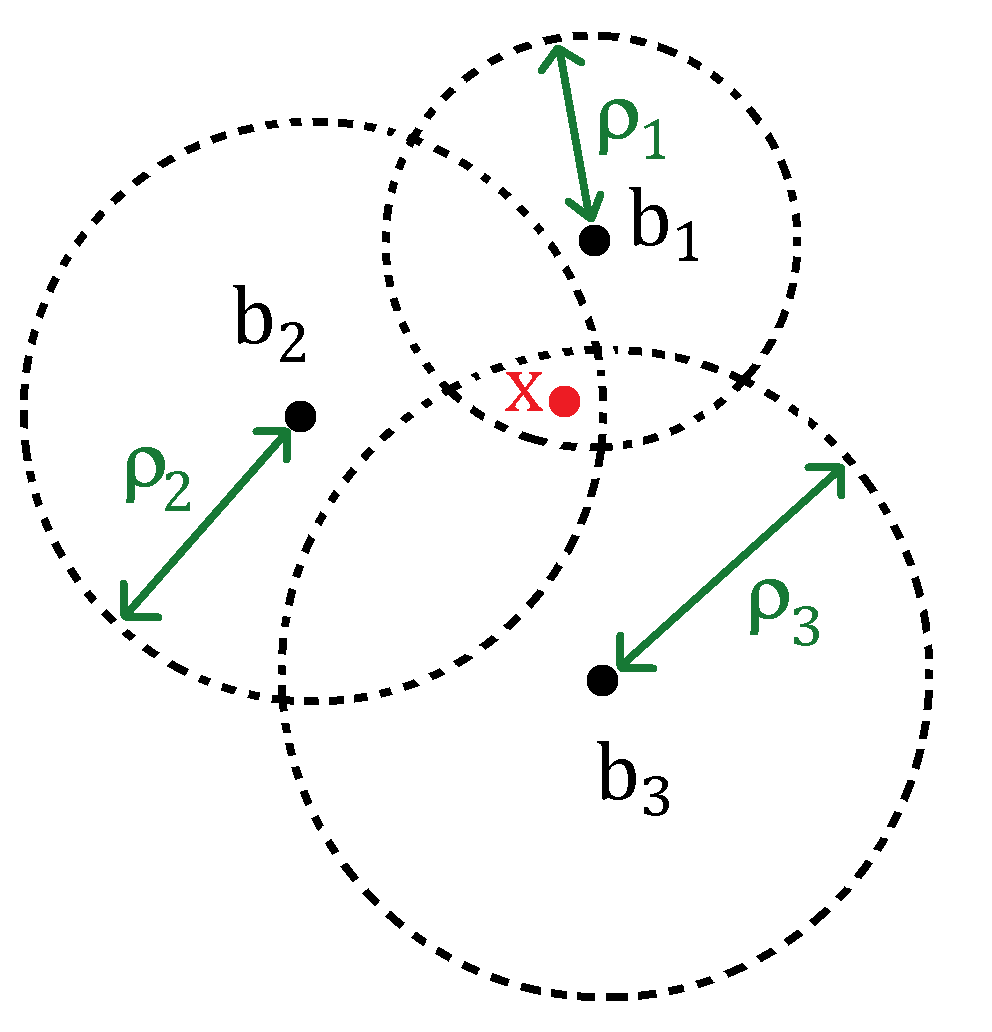Non-linear least squares¶
The non-linear least squares problem is
where r:\R^n→\R^m is the residual vector. The ith component of residual vector is r_{i}(\vx):\R^n→\R. The non-linear least squares problem reduces to the linear least squares problem if r is affine, i.e. r(\vx) = \mA\vx-\vb.
Example: Position estimation from ranges

Let \vx \in \R^2 be an unknown vector. Fix m beacon positions \vb_{i} \in \R^2,\ i = 1,\dots,m. Suppose we have noisy measurements \vrho \in \R^m of 2-norm distance between a becon \vb_{i} and the unknown signal \vx, i.e.
$$ ρ_{i} = |\vx- \vb|_2 + ν_i \quad \text{for } i=1,\dots,m. $$ Here, \vnu \in \R^m is noise/measurement error vector. The position estimation from ranges problem is to estimate \vx given \vrho and \vb_i, \ i = 1,\dots, m.
A natural approach to solve this problem is by finding \vx that minimizes \sum_{i=1}^m(ρ_{i} - \|\vx- \vb\|_2)^2. Define r_i(\vx) := ρ_{i} - \|\vx- \vb\|_2. Then we can estimmate \vx by solving the non-linear least squares problem
In contrast to linear least squares program, the non-linear least squares program generally contain both global and local minimizers. We can will use the following approach to find a minimizer of NLLS.
Gauss-Newton method for NLLS
Given starting guess \vx^{(0)}
Repeat until covergence:
- linearize r(x) near current guess \bar{\vx} = \vx^{k}
- solve a linear least squares problem to get the next guess \vx^{k+1},
Linearization of residual¶
We can solve non-linear least squares problem \eqref{Non-linearleastsquares_prob} by solving a sequence of linear least squares problem. These linear least squares subproblem results from linearization of r(\vx) at current estimate of the ground truth \vx.
The linear approximation of r(\vx) at a point \bar{\vx} \in \R^n is
where A(\bar{\vx})\in\R^{m\times n} is the Jacobian of the mappring r(x) at \bar{\vx} and b(\bar{\vx}) = A(\bar{\vx})\vx - r(\bar{\vx}) \in \R^m. The Jacobian of r(x) at \bar{\vx} is
We get the following minimization program after replacing r(\vx) with its linear approximation at \vx^{(k)}:
Starting at a current estimate \vx^{(k)}, we can determine the \vx^{(k+1)} by solving the above linear least squares program.
Dampening¶
For ease of exposition, let
We assume that \bar{\mA} is full rank. Consider
Here, \vx^{(k+1)} is the k+1 Gauss-Newton estimate. Note that (\bar{\mA}\trans\bar{\mA})^{-1}\bar{\mA}\trans\bar{\vr} solves \min_{\vx\in\R^n} \|\bar{\mA}\vx - \bar{\vr}\|_2^2. Let
The dampened Gauss-Newton step is
where \alpha \in (0,1].
Dampened Gauss-Newton method for NLLS
Given starting guess \vx^{(0)}
Repeat until covergence:
- linearize r(x) near current guess \bar{\vx} = \vx^{k}:
\quad r(\vx) \approx r(\bar{\vx}) - A(\bar{\vx})(\vx-\bar{\vx}) - solve a linear least squares problem:
\quad \vz^{(k)} = \mathop{\text{argmin}}_{\vx\in\R^n}\|A(\bar{\vx})\vx - r(\bar{\vx})\|_2^2 - take damped step:
\quad \vx^{(k+1)} = \vx^{(k)} - \alpha^{(k)}\vz^{(k)}, \quad 0<\alpha^{(k)}\leq 1
until converged